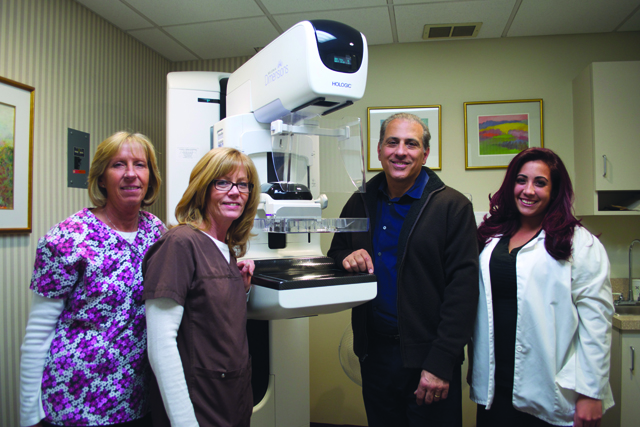Women of the North Fork take note: 3-D mammograms, a new diagnostic and screening technology that studies suggest can detect breast cancer earlier than a traditional 2-D mammogram, is now available locally.
“We have gone from film screen, to digital, to now 3-D,” said Monica Mignone, chief technologist at North Fork Radiology in Riverhead. “It’s truly amazing.”
A study published in the Journal of the American Medical Association in June 2014 found that the new technology resulted in 15 percent fewer false alarms and is better at spotting small and/or aggressive tumors.
The staff at North Fork Radiology agrees that the benefits are obvious.
“The callback rate is reduced and the sensitivity is greatly improved,” Mignone said.
A callback happens when the machine picks up something suspicious and a patient must return to the office for further testing or a biopsy. Only about 10 percent of callbacks result in a cancer diagnosis, according to the American Cancer Society.
The organization now recommends that women with an average risk of breast cancer start undergoing yearly mammograms at age 45 and then opt for the exam every other year starting at age 55. It no longer recommends self-exams.
3-D mammograms especially benefit women with dense breast tissue for whom a traditional mammogram might not detect a small tumor, Mignone added.
Although the radiation risk is slightly higher because the machine typically takes both 2-D and 3-D images, the exposure rate is still well below what are considered dangerous levels.
The technology, also called Tomosynthesis, is virtually the same as a CT scan. It takes multiple 1 millimeter images of the breast and reconstructs them into a 3-D image.

“It allows us to peel away the layers and see underlying lesions that might be obscured by other tissue,” the JAMA study’s lead author, Dr. Sarah Friedewald, co-medical director of Caldwell Breast Center and section chief of breast imaging at Advocate Lutheran General Hospital in Park Ridge, Ill., told NBC News. “You can think of regular mammography as showing a closed book. With 3-D you are able to page through the book one page at a time without other information superimposed.”
And the 3-D exam process is only a tiny bit longer than a traditional mammogram.
“It slows us up maybe three minutes per exam,” Mignone said. “I don’t think the patient would even notice.”
The Roanoke Avenue facility first installed the machine, called a Hologic Selenia Dimensions unit, in December 2014. It performed its first 3-D mammogram in March 2015 and since then about 3,700 women have been screened using the new technology.
It is the nearest-available machine for women on the North Fork. The Ellen Hermanson Breast Center at Southampton Hospital on the South Fork also has the same unit.
Mignone said about 50 percent of patients have opted for the new screening tool since it became available. Those who don’t usually cite cost as the issue (not all insurance carriers will cover a 3-D exam, though most Medicare programs will.)
3-D exams increase the detection rate of all cancers by 29 percent, and perhaps more importantly, increase the detection of invasive cancers by 41 percent, said Dr. David Kirshy, chief radiologist at North Fork Radiology, citing figures found in the JAMA study.
“This is one of the best technologies to come out. It’s a very accurate way of looking at the breast tissue,” he said. “And we feel this is one of the premiere units out there.”
The new technology was about a $1 million investment for the business, he said.
Dr. Kirshy said he recommends the new technology to patients, as it reduces the number of false alarms, which means less unnecessary stress for women, and because it can spot lethal tumors earlier, which can result in lower mortality rates.
“Early detection is the key,” he said.
This story was originally published in the 2016 edition of northforker Wellness


